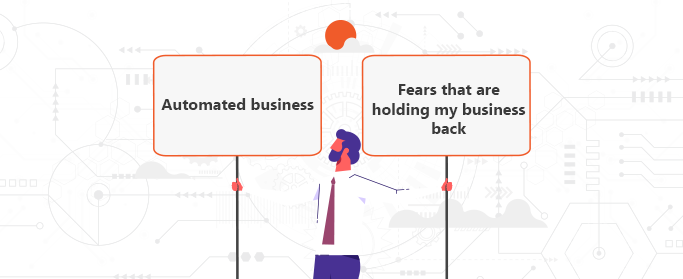More and more jewelry companies recognize that the lack of an integrated system could lead to a stagnating business. While the benefits of such systems are significant, business leaders are often apprehensive about starting the implementation in their organization. And that is not out of thin air.
The fear of the implementation versus the fear of missing out on the benefits is the struggle many of these leaders face.
In today’s article, we discuss the fears that hold jewelry business owners back from making a decision.

Fears on the management level
While jewelry inventory and ERP systems have become widely available for small and mid-size jewelry companies, certain fears hinder them from making instant decisions.
1. Bad experience
 A few of these companies have attempted to implement jewelry inventory management or ERP systems already, and they have been left with a sour taste. Lack of features or flexibility, slow progress, and poor customer support are just some of the unpleasant memories that influence our decision-making when selecting our next software. It is emotionally distressing, and we naturally want to avoid a similar situation and mitigate your risks.
A few of these companies have attempted to implement jewelry inventory management or ERP systems already, and they have been left with a sour taste. Lack of features or flexibility, slow progress, and poor customer support are just some of the unpleasant memories that influence our decision-making when selecting our next software. It is emotionally distressing, and we naturally want to avoid a similar situation and mitigate your risks.
The solution: Conduct extensive research and be aware of the downsides of the chosen software (as perfect software doesn’t exist).
2. It’s going to cost too much
Yes, it’s going to cost you money. But that money is not a six-figure sum, as it would be with Microsoft Dynamics, for example. Today’s jewelry management software is quite affordable. The most significant upfront cost is the software configuration cost, but often, this implementation cost is less than the cost of a fancy e-commerce website.
Also, think hard about any customizations you’re considering. While you might not be able to use most ERP solutions out of the box, extensive customizations can cut into your budget and put your project behind schedule.
The subscription-based (SaaS) licensing that our system, PIRO Fusion, offers allows you to pay for the license monthly—a great chance for SMBs to start using a comprehensive system for a fraction of the cost of a top-level ERP.
The solution: Avoid unnecessary custom developments during the implementation. The overall cost of acquisition always depends on your requirements. Focus on the must-haves and be ready for a compromise with any nice-to-have requirements.

3. It’s going to take too long to implement.
Time is relative. Implementing comprehensive jewelry software inevitably takes a few months, half a year, or more. But for how long will you use this system? Ideally, you will not consider changing your system within a decade. The six months of money, effort, and resources you put into the project will have a 10-year impact on your business.
Taking shortcuts to reduce the implementation time is never a good idea.
The solution: having a solid system that could define your overall business operation for a decade requires many resources. The time you spend on this project is one of these resources. You should start a software project only if you are fully ready to allocate what it takes. We have no better advice.
4. It’s going to require too much change in my current processes.
Change is a crucial aspect of this story. While everything is in constant flux around us, including the business environment and consumer behavior, as an organization, we must be prepared to adapt when needed.
At what level will a jewelry ERP change your processes? It depends on the software you selected. While some ERPs are out-of-the-box (you don’t find much like this in the jewelry industry), others, like PIRO Fusion, are built to be flexible. Our approach is to tailor the system to the company's needs as much as possible, with as little custom development as possible. The downside of this is that the implementation will inevitably take longer.

On the other hand, the implementation of new management software is a great chance to identify and enhance bad processes. Automating a destructive process will not bring any benefit; instead, it could magnify the negative effect.
The solution: while a certain level of change is necessary for your processes, the goal of such a project is not to change them and force you to work radically differently. The approach that PIRO represents is to automate your processes without forcing you to redesign them significantly.
5. Low system usage - No one will use the system, anyway.
I would break this down into two aspects. Why won't anyone use it? Is it because your employees are elderly people and reserved towards software, or are they resisting change?
We can agree that the first one is a given thing and is difficult to change. A software like this is not for them, so you better put the idea into your drawer.
The second aspect is quite significant and sensitive. Can you force them to accept the change and use the system? The answer is ambiguous. You must educate them and sometimes change the company culture before making any move. And I’m not talking about the training on how to use the system. Education must start way before the system implementation. They must understand why you are doing this, why the company needs this, and what the benefits will be.
The solution: Identify the source of the problem and speak to them about your plans. Employees have their own fears, and they are pretty different from yours. Make sure you address these fears before they bring it up. Some of these fears are sensitive, and they might not even bring it up. You have to do it. Talk to them about the positive sides of the change.
People buy-in – the employee fears
One of the biggest obstacles among employees to any change initiative, such as implementing an ERP, is fear. Companies with enough experience know how to handle this and have their change management plan ready.

Change management involves guiding people through the process of change, and it's crucial for success when implementing new technologies, such as ERP software.
Here are a few fears you need to address.
1. Losing their job
No one will lose their job because of an ERP. The system only helps them become more efficient. It might happen that some activities will become redundant, but you will find them new tasks. For example, if someone is employed to update the products on the website, but the ERP integration automates it, you must find this person a new position. Make it clear that you are not planning to let anyone go.
2. Fear of control
No employee will tell you this to your face, but it's a fear that disturbs them in a latent manner. They will think that you want a transparent system because you seek greater control over their activities.
Although transparency and better control are valid goals for a software project, they're not against the employees. You want transparency over the resources, and you seek better control for efficiency. Control is never against the employees; it is more for the greater good: to become a more competitive business.
3. Breaking the routine
People live their lives by their routines. You probably start your day with coffee, right? At work, you also follow routines. You check emails, you check order statuses, and so on.
Your employees also follow their routines. This routine will inevitably break when a new system is implemented. If you could read your employees' minds, you might find thoughts like: "In the past 10 years, I handwritten all the invoices; why do I have to type into a system now?"
The fear of breaking routines is another hidden reason why they might resist change. While asking them directly if this is a problem might not bring you honest answers, make sure you talk about this and ensure that you are aware of their concerns. Tell them that this is not breaking routines but learning new ones.
Overall, talking to them about the changes or even involving them in the software selection process will help dissolve some of these fears. The last thing you want to deal with is seeing your people sabotaging your initiative.





